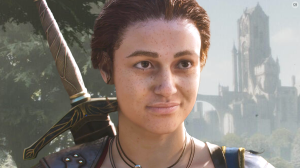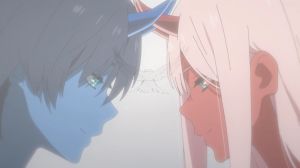
What if a woman had found the cane that became the mighty hammer Mjolnir, transforming her into Thor? Or what if a radioactive spider bit somebody else besides Peter Parker? At one point in comic book history, these scenarios sounded absurd enough that they were written about as part the hypothetical alternative Marvel timeline found in the series What if? And yet today, variations of both stories are playing an integral part of the Thor and Amazing Spider-Man series.
Videos by ComicBook.com
In reality, for the past 35-plus years, What If? has proven to be quite prescient – a worthwhile predictor of the “House of Idea’s” future. While the original premise of the series was a semi-serious look at the potential “butterfly effect” that would take place if certain landmark moments in comic book history veered off their original path, as time has gone on, various creators have mined elements of What If? to create new, in-continuity stories.
Here are 10 examples of landmark Marvel storylines that, intentionally or not, were born from some of the alternative scenarios first hatched in the pages of What If?

10. What if Spider-Man Joined the Fantastic Four?
In the very first issue of the What If? series in 1977, Roy Thomas and Jim Craig reimagined 1963’s debut issue of Amazing Spider-Man by having the Fantastic Four actually accept Spidey’s request to be a member. In the story, Spider-Man’s membership of the Fantastic Four (now named Fantastic Five) earns him general acceptance from the people of New York, including Daily Bugle publisher J. Jonah Jameson. However, things go sour when Sue Storm leaves the group to be with Namor, claiming the superteam has continually ignored her since Spider-Man joined the crew. The issue ends with Spider-Man regretting he ever became a FF member.
What Actually Happened: In mainstream comics, Spider-Man would replace the Human Torch in the wake of his buddy’s death, helping to launch the Future Foundation, or FF, alongside Sue, Reed Richards and Benjamin “The Thing” Grimm. During his stint on the team, Spider-Man more or less fills the “comic relief” quota that was once occupied by Johnny. In Fantastic Four #600, Spidey does stumble upon Johnny after the character makes his escape from the Negative Zone. Johnny promptly asks his friend why he’s wearing the funny costume.

9. What if the Hulk Had Always Had Bruce Banners Brain?
What If? #2 (vol. 1) put forward the idea that the Hulk was able to maintain Bruce Banner’s supreme intelligence at all times. This development sets off a chain reaction of events that leads to the Avengers never being formed since Loki’s manipulations of the Hulk was what originally brought the team together in Avengers #1, and the dissolution of the Fantastic Four after Banner/Hulk help Reed Richards discover a way to transform the Thing back to Benjamin Grimm. To top if off, Charles Xavier decides he rather perform scientific research with Reed and Bruce, and as a result, he never starts the X-Men.
What Actually Happened: In the midst of Peter David’s revolutionary run on The Incredible Hulk in the late 1980s/early 1990s, he establishes multiple Hulk personas, including the nastier, but more intelligent Grey Hulk, along with the almost child-like savage Green Hulk. These plotlines come together as part of the landmark Incredible Hulk #377, which sees the personalities/intellects of Banner, Green Hulk, Grey Hulk, merge together, creating a character that mixes Hulk’s strength with Bruce’s brains.
While David’s story didn’t affect the Avengers, X-Men and Fantastic Four, it did have far-reaching impacts on the Hulk universe, as the character joins the Pantheon, a group of superpowered, individuals.
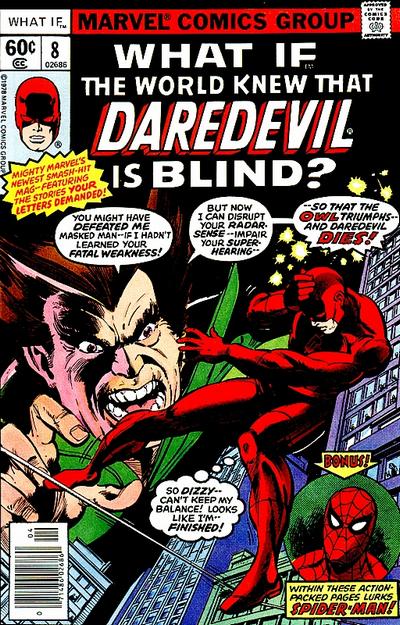
8. What if the World Knew Daredevil Was Blind?
Don Glut and Alan Kupperberg revised the events of Daredevil #2 with What If? #8 (vol. 1). In this story, Electro discovers that Daredevil is blind when the hero doesn’t react to a flash of light in front of his face. Electro turns around and sells this secret to the Daily Bugle. Daredevil’s villains try to use his disability against him, while Karen Page, who deduces that the hero is actually Matt Murdock, convinces her love interest to get a surgery that will restore his sight. While seeing a doctor, the tyrant Duke Klaus Kruger attacks, and Matt is inadvertently exposed to additional radiation, which depowers him. At the end of the story, Murdock outs his alter ego to the press, and retires from the superhero business, becoming a district attorney.
What Actually Happened: Daredevil’s secret identity is first discovered by the Kingpin during the “Born Again” arc in the mid-1980s. Then, during the landmark Brian Michael Bendis/Alex Maleev run on Daredevil in the early 2000s, the duo craft the storyline “Out,” which features one of Daredevil’s enemies selling his secret identity to the press. Murdock denies the story and promise to sue the paper that published it, but that doesn’t stop his rogue’s gallery from trying to take advantage of their newly exposed adversary.
In the most recent Daredevil comic book series by Mark Waid and Chris Samnee, Murdock admits in a court of law that he’s Daredevil. He’s disbarred from New York, so Matt is now spending time practicing law and fighting crime in San Francisco.
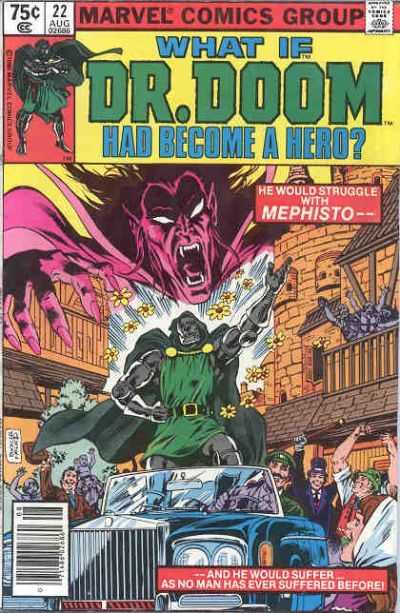
7. What if Doctor Doom Had Become a Hero?
While What If? had a habit of speculating about what would happen if a hero turned evil, issue #22 marked the first time the series examined the impacts of one of the Marvel Universe’s most nefarious villains becoming a hero. Adapting from Fantastic Four #5, while working on an experiment, Victor Von Doom adheres to Reed Richards’s warning about his calculations being incorrect, saving Doom’s face from being destroyed. Doom continues to try and find ways to rescue his mother’s soul from hell, but does so with less bitterness and hostility. When he solicits advice from a group of monks, they give him golden, more virtuous-looking armor. After Doom retrieves his mother’s soul, Mephisto is none too happy and demands the soul of Doom’s love, Valeria in return. The story ends with Doom working tirelessly to reunite with Valeria.
What Actually Happened: Like any good comic book villain, creators have spent plenty of time over the years adding layers of complexity to Doom’s persona. During John Byrne’s writer/artist run, there was a renewed focus on Doom trying to rescue his mother’s soul from the netherworld. But he never went full hero until more recent times. In the wake of the Secret Invasion and Siege storylines, Doom turns on Norman Osborn after the former Green Goblin continues to harass Doom’s ally Namor. A few years later, it is revealed that Doom has suffered brain damage. During the “Fantastic Four: Three” arc, he attends Johnny Storm’s funeral as a friend and he abdicates his throne in Latveria, opting to join the Future Foundation.

6. What if Spider-Man’s Clone Had Lived?
What If? #30 (vol. 1) actually preempted one of the comic book industry’s most reviled storylines by about 13 years. Bill Flanagan and Rich Buckler joined together to create story speculating what might have happened if Spider-Man’s clone, as featured in Amazing Spider-Man #149, had actually lived. The story takes place immediately after the two Spider-Men fight. The winning Spider-Man goes off to live his life when he finds himself misremembering facts from the past three years, like the death of Gwen Stacy, and that he no longer lives with his Aunt May. The random amnesia leads Spider-Man to Miles Warren’s laboratory where he discovers he’s actually the clone, while the real Spidey is being held captive. Clone-Spider-Man struggles with his conscience, but eventually frees Spider-Man, and the two agree to live together and share in the responsibilities of being Peter and Spidey.
What Actually Happened: This comic came pretty close to the actual “Clone Saga” storyline. As part of the 1990s multi-year arc, Peter’s clone turns out to be alive and comes back to New York. After fighting side-by-side for a number of issues, a test reveals that Peter is actually the clone, and his doppelganger, Ben Reilly, is the genuine article. This forces Peter to quit being Spider-Man and ride off into the sunset with his pregnant wife Mary Jane. Circumstances (i.e., dipping sales) brought the original Peter back to the webs, and in a stunning turn of events, Norman Osborn is resurrected and revealed to be the mastermind of the “Clone Saga.” P.S., it turns out that Peter has always been the real Spider-Man and that whole “you’re a clone” business was just another one of the Green Goblin’s mind games.

5. What if Wolverine Had Killed the Hulk?
Rick Margopoulos and Bob Budiansky brought readers a revised version of one of the most famous comics of the 1970s – Incredible Hulk #181. In What If? #31 (vol. 1), Wolverine succeeds in slaying the Hulk. As a result of his victory, Wolverine is recruited by Magneto to join the Brotherhood of Evil Mutants. Wolverine accepts the offer and infiltrates the X-Men’s Danger Room, only to double cross Magneto. The storyline ends with both Wolverine and Magneto dead.
What Actually Happened: As part of their “Old Man Logan” storyline in 2008-09, Mark Millar and Steve McNiven jump Wolverine 50 years into the future. There, the Marvel Universe has become overrun with villains who have banded together, and Logan, having retired the Wolverine persona out of shame, is living in a fiefdom overrun by the Hulk. When Logan learns that the incestuous grandchildren of the Hulk and his cousin She-Hulk have murdered his family, he sets out on a path of vengeance. In the storyline’s climax, the Hulk appears to have cannibalized Wolverine, only for the ‘Ol Canucklehead to regenerate inside of the green monster’s stomach, clawing his way out and killing him.
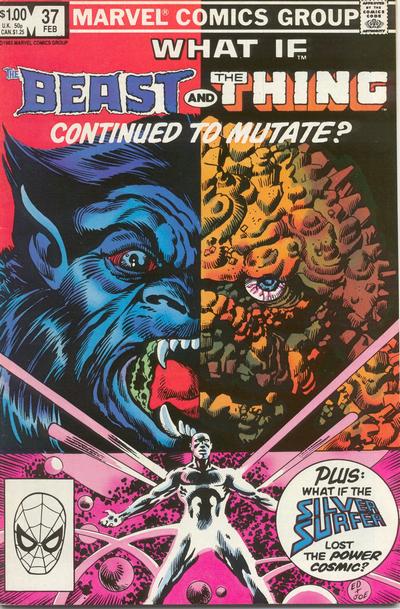
4. What if the Beast Continued to Mutate?
In What If? #37 (vol. 1), Tom DeFalco and Arvell Jones imagined what would happen if everyone’s favorite furry blue mutant, Hank McCoy, aka, the Beast, continued to physically mutate. For this 1983 story, Hank’s mutation transforms him into a more savage creature, similar to the Hulk. When he almost cannibalizes Jean Grey, Professor X interferes and uses telepathy to calm the Beast. Xavier then finds a new home for Beast alongside Ka-Zar in the Savage Land.
What Actually Happened: A key subplot in the Grant Morrison run on New X-Men in the early 2000s, is how Hank mutates into an enhanced feline form of the Beast. Hank initially has trouble adapting to his new body, and is further humiliated when his girlfriend Trish Tilby breaks up with him after she’s accused of “bestiality.” Hank is also concerned that his mind might eventually devolve into something more animal-like and savage (like what occurred in What If?). At one point, Hank is offered a cure to his physical condition, but is talked out of it by Wolverine who says it would set a bad precedent for mutant-kind.
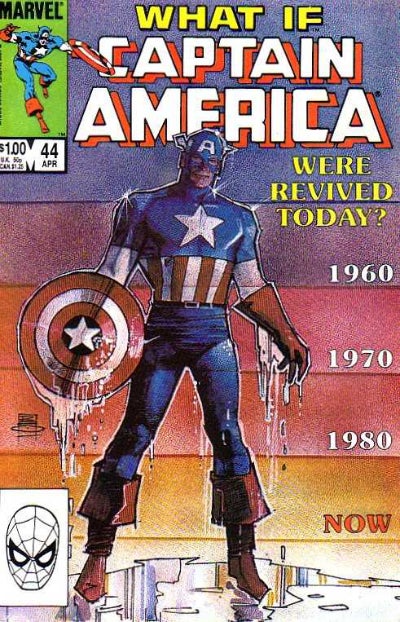
3. What if Captain America Were Revived Today?
Demonstrating the age-old conundrum of how much real-time actually passes in comic books, What If? #44 (vol. 1) examined what might happen if Captain America were revived “today” (which in this case was the early 1980s) versus his 1963 return as featured in Avengers #4.
Creators Peter Gillis and Sal Buscema actually use the story as a means to comment on post-Richard Nixon America (a few years before Alan Moore did it in far more iconic fashion with Watchmen). Per What If?, without the Silver Age resurrection of Cap, the Avengers would have never stayed together. But beyond that, the comic features a story where Cap and Bucky’s replacements from the 1950s are resurrected, and become tools for an ultra-right wing fascist government. The real Captain America, Steve Rogers, is eventually reanimated and he defeats the posers. He then admits he’s ashamed of the political state of affairs in the United States. But a stirring rendition of “God Bless America” brings a tear to Cap’s eyes.
What Actually Happened: In advance of 2011’s Captain America: The First Avenger film, Mark Waid and Jorge Molina created a five part miniseries, Captain America: Man Out of Time, that reimagined what would happen if Cap was thawed out by the Avengers in the 21st century. This very elegantly told story features a lot of fish out of water moments for Cap, like learning about President Franklin Delano Roosevelt’s death via the internet. But the ultimate lesson of the tale is Captain America is more than just a combatant and a soldier, but also a symbol for a greater good and heroism in the Marvel Universe.

2. What if Wolverine was an Agent of S.H.I.E.L.D.
Wolverine has long described himself as the “best there is at what I do,” but it wasn’t until What If? #7 (vol. 2) that he proved capable of being a hired gun for S.H.I.E.L.D. The Jim Valentino/Rob Liefeld issue takes place after the events of Incredible Hulk #181. Wolverine is hired by Nick Fury for a one-off mission with S.H.I.E.L.D. to investigate some stolen life model decoy tech. Wolverine is successful in breaking up the Hydra-led conspiracy, so Fury asks Logan to permanently join as his No. 2. When Baron Von Strucker succeeds in killing Fury, Wolverine becomes the head of S.H.I.E.L.D.
What Actually Happened: As part of the critically acclaimed Mark Millar/John Romita Jr. run on Wolverine in the mid-2000s, Logan has been brainwashed by Hydra and the Hand and goes on a one-man terror spree, involving nearly everyone of significance in the Marvel Universe. Wolverine is eventually apprehended and deprogrammed by S.H.I.E.L.D. Wolverine is justifiably ticked off, so with S.H.I.E.L.D.’s assistance and support, he sets his sights on stopping Hydra and the Hand. The arc ends with Wolverine killing the Hydra agent Gorgon before he has an opportunity to assassinate Fury.
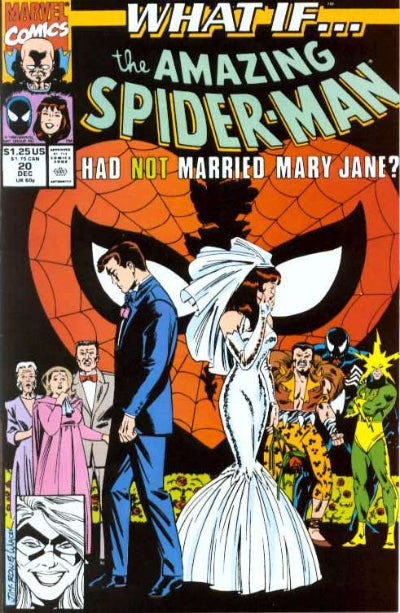
1. What if the Amazing Spider-Man Had Not Married Mary Jane?
Oh boy … this won’t be pretty. For the first time in What If? history, the title gave readers a two-part story in issues #20-21. In the first part of this Danny Fingeroth/Jim Valentino collaboration, Peter Parker proposes to Mary Jane Watson but after realizing that his life as Spider-Man will always put her in danger, he gets cold feet and stands her up at the altar. To get his mind off things, Spidey starts freelancing for the Silver Sable before deciding to get back in the game. He looks up his old flame, Felicia Hardy, aka, the Black Cat and the two get back together. Spidey and Cat get married under secret identities to protect their loved ones, except the Vulture catches wind of the whole affair and attacks Peter’s Aunt May. Peter learns that Cat’s blabbing let their secret out and he breaks it off with her. In a moment of redemption, Black – who still views MJ as competition – is faced with having to save Mary Jane from falling off a building and gets shot by Sable’s henchman Paladin for her troubles (Paladin thought Cat was going to push MJ). The end of the tale sees potential romance between Peter and Sable.
What Actually Happened: After struggling with the idea of a married Spider-Man for nearly two decades, Marvel’s editorial department mandated that the marriage be dissolved as part of the “One More Day” storyline. Peter makes a deal with Mephisto to save his dying Aunt May in exchange for erasing his marriage (and protecting his recently exposed identity). Peter’s non-marriage is explained away in “One Moment in Time” a few years later. In that story, Peter misses his wedding after he is trapped by Electro. In between “One More Day” and “One Moment in Time,” Spidey and Black Cat do spend a hot and steamy night together (Spidey asks to keep the lights off to protect his identity), but the word “marriage” is never uttered.







